Zootopia Suit Riot
“It doesn’t have to be realistic, it has to be believable,” said Darrin Butters, as we watched a variety of animals practicing their walk cycles on 2 legs. Darrin Butters is a Disney animator, and has been for 20 years. He visited The New School on Thursday, Feb 25th to discuss Disney’s new movie Zootopia (in theatres March 4th).
“I started on Dinosaur… and not The Good Dinosaur…” he quipped with a lop-sided grin. Butters was picked up by Disney at a SIGGRAPH convention when they were starting production on Dinosaur. They were looking for animators who could handle a computer, or at least learn how. But it was his theatrical background that really got Disney’s attention, and that ‘couldn’t be taught.’
As a young kid in Nebraska, Butters put on magic and puppet shows, and animated flipbooks in 1983 [he didn’t have access to animation iPad apps, as his own children do now]. Later on he moved to Houston and started work at an ad agency, and began to teach himself animation on early computers. Butters described how lengthy the process was to create one of his tests of a polygon flying around his face. He needed a special Photoshop plug-in to composite/print the animation onto the film-strip, which involved big TIFF files, and he had to hand-air-brush the shadows of the polygon on his face. But it all paid off in the end, and today, he has animated one of the most viral scenes of Zootopia, Disney’s 55th feature film.
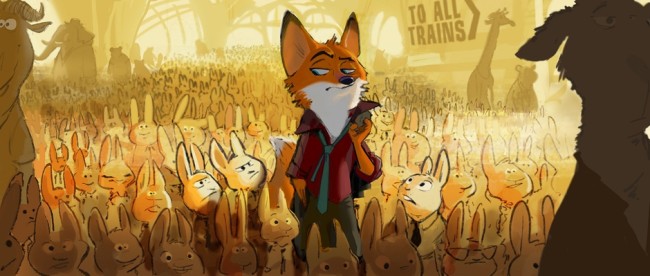
Zootopia was born out of a strong need for Disney’s story-trust to create another walking-talking-animals-in-clothes movie, like Robin Hood. The “story-trust” was a group of Disney creators founded by John Lasseter and Ed Catmull, who believed that ‘if you haven’t made a movie, you can’t give notes on a movie.’
Disney ventured into the past and the present, in their research for pre-production. By visiting the Disney Animation Research Library, animators saw that many of the problems of getting an animal’s snout to form mouth shapes for speaking had already been solved, in the original pencil tests of the movie Robin Hood. And by visiting Kenya, animators saw that predatory and prey animals reach a sort of peace treaty around the water hole. This inspired some concept art that illustrates a tribe of zebras shaking paws with a tribe of lions in prehistoric Africa; as the lions agree not to eat the zebras, and the zebras agree not to spear the lions.
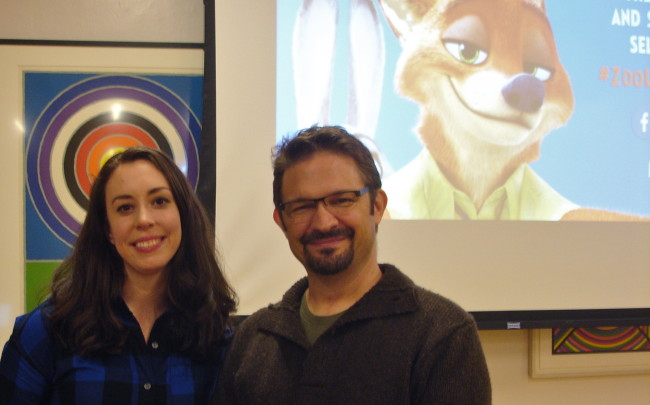
The New School host and Darrin Butters, Disney Animator
Today, Zootopia takes on a heady tone with its police-officer subject matter and elements of literal racial prejudice. Officer Judy Hops (the city’s first bunny cop) investigates a series of mysterious kidnappings and attacks, which turn one species of animal against another in the big city of Zootopia. But it is not Disney’s intention to influence people one way or another, Butters reminded us. They are just interested in creating an entertaining story out of a specific premise: how do both predatory and prey animals live in a wonderful city they built together? Influential or not, the use of “predator” and “prey” as opposed to “herbivore” and “carnivore” can shift the conversation.
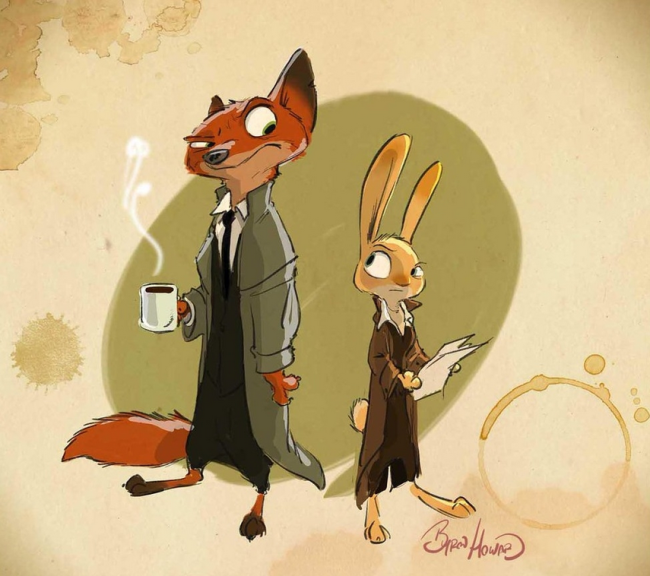
This reminds me of Mulder and Scully.
Disney animators made many, maybe thousands, of animation tests to nail down the right mix of anthropomorphized animal behavior. Most of them wound up as background characters in the movie. Butters animated a zebra holding a ‘Starbucks’ coffee cup, who blows on it to cool down, and then looks around nervously to check to see if it’s safe, before he starts to lap up the coffee. A popular example of other animal behavior includes a herd of wildebeest (gnus). The herd does not start crossing the street when the light changes, but waits until one individual decides to go, and then they all move. Butters says that this scene gets a special laugh when played for New York audiences, and he didn’t know why until he walked around New York himself. I particularly enjoyed how Nick Fox and Judy Bunny avoid getting stepped on by traveling in the wake of a porcupine, who splits the herd as the wildebeest give his sharp quills a wide berth.
The animators also experimented with how animalistic Officer Hops would be. They had to strike the right balance between two sources. One was original rabbit behavior, such as ‘binkying,’ which is a specific jump with the rear legs kicking to the side, and the other was the original performance of voice actress Gennifer Goodwin (Once Upon A Time!) who really emoted the sincerity and happiness of the character. Eventually binkying found its place when Officer Hops used it to kick down a door. And Hops’ original rabbit behavior of paw wringing and wide-eyed glances was toned down in later animation tests.
![Sloths at the DMV, from storyboards to final render. [original photos from Animation World Network]](https://asifaeast.com/wp-content/uploads/2016/03/layoutsloth-650x272.jpg)
Sloths at the DMV, from storyboards to final render. [original photos from Animation World Network]
There was also a lot of notes back and forth with the sloth modeler’s and riggers, since the laugh wasn’t originally intended, and the character was not designed for such a large reaction. But it was well worth the effort, as Butters found out from early audiences. There are three specific laugh-points of the scene: 1) when you realize, ‘oh he is going to get the joke,’ 2) when you realize that he is getting the joke, and 3) when you realize that this might never end. Butters started his work on Zootopia after Big Hero 6 wrapped, sometime around November 2014.

Disney animators also have a special tool they use when they want to create a beautiful piece of acting: John Lasseter. At the Q&A, I discovered one of my favorite scenes was acted out by Lasseter himself. His performance was captured on a cell-phone camera and used as reference. In the film, Nick the Fox has to figure out how to eat a tiny piece of cake with a tiny fork… he carefully, surgically almost (or with the fingers of a lock picker) picks up the tiny plate and utensil, and takes just one forkful of the cake slice onto his tongue… His reaction tells you that not only is the cake good, but that it was worth the effort to politely sample a gourmet dessert. In the animation studio, Lasseter used a quarter as a plate and a toothpick.
Animation takes precedence in some scenes. Apparently in the chase scene between Officer Hops and a weasel, the characters were animated first and the layout team built the background characters and set around the action (at least for part of the first half of the chase where they were the small animals). Later on in Little Rodentia, a shift in scale was heightened by liberal use of tilt-shift on apartment buildings.
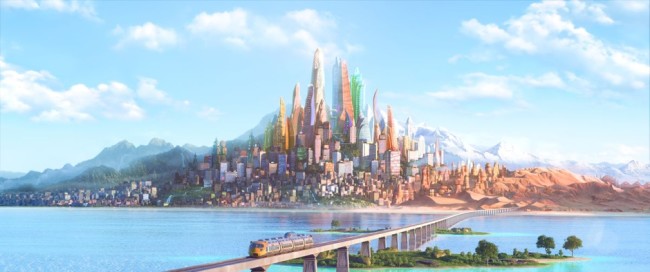
An enormous amount of world-building went into Zootopia. Sahara-Square was inspired by Dubai, and features one giant skyscraper hotel styled as a glass palm tree. Tundra-Town is filled with Russian inspired architecture, and blends buildings into the background (animals like to live in naturalesque settings). All the business signs featured are animal based puns (such as Ewe-Haul for U-Haul). And in the Rainforest-District, everything was designed to look perfect when it was wet, and when it was dry. This included fur, and sources list anywhere from 50-60 different animal furs were researched for the movie. For instance, did you know polar bear fur is actually translucent, and only appears white due to its translucent nature? [Thank Butters for the tip, but I seem to also remember Animorphs telling me that the reason polar bears get sick in zoos is because it’s easy for mold to grow into the fur in warm environments…]
Despite all of this research into talking-animal behavior, I worry that Disney did not exactly hit the mark. Take for example Shakira’s Gazelle Character (named “Gazelle”). When Shakira (of Hips Don’t Lie fame) was shown original character designs, she asked that it be redone with more meat on her bones, with curves and hips, and said, “[Gazelle] knows that she has an impact on the people who follow her and listen to her and that is something I’m aware of, I think all public figures have a social responsibility.”
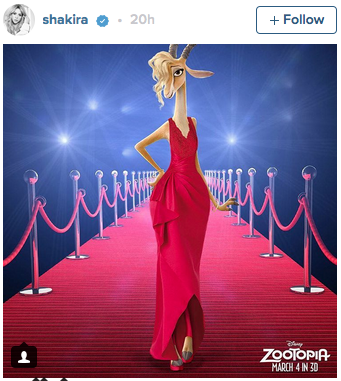
The Re-Designed Gazelle
Then there is the character of Officer Clawhauser, an overweight gay cheetah. No one says he’s gay, but his vaudeville style performance leaves little to the imagination. Clawhauser is introduced as a slob with a doughnut under his neck-fat, and is too distracted by his phone to properly perform his duties. His entire character arc is centered around an iPhone app. I know queer people who already struggle with weight and body issues, and I’m not sure how Clawhauser is supposed to help even younger gay or overweight people feel any better about it.
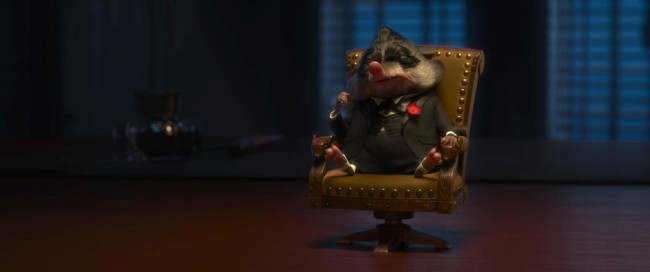
Many of the animals are slotted to ethnic stereotypes, which is probably the wrong message for impressionable children. When Officer Hops runs into a crime family, she runs into an exact parody of The Godfather played by a vole. How many Italians are sick and tired of being portrayed as the originators of organized crime? However, the character is redeemed by an excellent piece of animated action and lighting. The original Godfather featured unusual over-head lighting that is recreated, giving the vole a skull like appearance, with his heavy eyebrows. This inspired moment gives drama to one moment of his monologue, when for an instant the brows are raised and we see his eyes on the word “death.”
Zootopia ends with an awesome concert by Shakira/Gazelle. With a camera crane, we fly over a unique crowd of animals dancing, drinking, partying, and taking cell phone videos when they should be dancing more. Gazelle is in the center of it all, on a podium, singing and shouting in English and Spanish, encouraging everyone to shake it. She is surrounded by 4 very sexy tiger back-up dancers, that prowl and vogue around her (animated by Benson Shum). They give a new meaning to the predator/prey relationship. But…
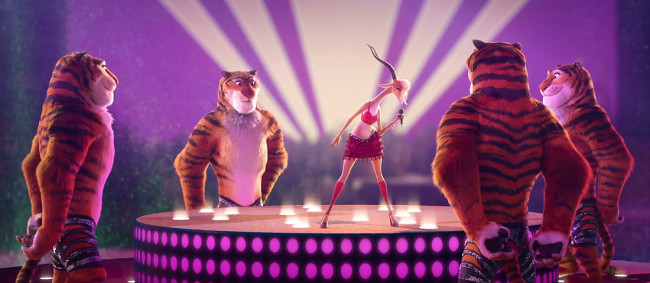
Inevitably, the film inspires discussion of the furry community. “Furries” are people who sexually identify with anthropomorphized animals, although you can find people today who will say that sex has nothing to do with it, and that they are content to have a “fursona” persona, just to dress up as an animal and party/rave with like-minded people. The internet (ranging from reddit to deviantArt) will show more graphic fan art, which can lead to darker places. Tony The Tiger’s Twitter account was recently hit up with requests to cream people’s cornflakes, and Kellogs had to remind the public to keep it PG, ‘in case any young cubs were reading.’ Cartoonbrew reported a petition to get ahead of the controversy and not draw artwork that would disturb young children, but apparently even the originator of that petition relented after she found some of the artwork mildly erotic. One of the audience members approached Darrin Butters after the Q&A and asked him if he knew about furries. Butters did know and politely expressed interest in looking at any fan art of the film.
It’s not all bad. Officer Hops is an inspired, honorable, intelligent, and brave policewoman. Butters told us that Disney did bring in a police officer to tell stories about being the first woman on her force. Zootopia does not portray police officers as corrupt or brutal, but it’s still hard to separate reality from fiction, when writers Jared Bush (Dumb and Dumber) and Phil Johnston (Wreck it Ralph) must have started writing around the time of the Trayvon Martin shooting in 2012. The movie directly discusses whether or not animals/people’s behavior are driven by ‘biological imperative.’ I’ll let you watch the movie to see how that resolves itself.
Warning, I did tear up during several different scenes in this movie, as the Fox and Rabbit confronted each other and discovered aspects of their philosophies that didn’t always mesh. [update: when I saw Zootopia in Union Square Feb 24th]

I would love to see Zootopia again, as well as Zootopia II (2ootopia?), III, IV, and V. It’s definitely a fascinating world, and there is room for many adventures with Officer Hops and Nick Fox. Zootopia opens this Friday March 4th. If you are a parent looking for a movie for your kids, be forewarned that this will start conversations that you might not be ready to have. But you should have them, and I think there are great lessons to be learned from it. Otherwise, if you are just an animator, get to the theatres soon, and revel in a masterpiece of world-building.
Further Reading:
New Hyperion Render Engine for Fur
Significant Plot Rewrite Shifting Main Character from Fox to Bunny
New Fur techniques simulating wind and muscle
Proof Zootopia is Marketing To Furries
Set Design inspired by Antonio Gaudi
Social Issues Raised in Zootopia (oh boy I didn’t even mention the flashback scene)
http://variety.com/2016/film/news/zootopia-again-tops-in-tv-ad-spending-1201713131/
http://hellobeautiful.com/2016/02/24/idris-elba-zootopia-tom-hanks-toy-story/





